Festive Wines Yule Love
Celebrate the Season With Our Holiday Wine Guide
Certain beverages just seem to make more sense in certain seasons. Margaritas don’t necessarily scream
fall foliage, but they do nudge us to find a spot poolside in the summer.
Each wine also suggests a certain season, and certainly the vinous world is so diverse that we could spend several
seasons pairing different wines with the changing temperatures and seasonal ingredients without running out of new options
for slaking our thirst (and our curiosity).
When the chilly winds and snow of winter start to blow, certain wines that make sense in
the spring (such as fresh rosé) or summer (think spritzy and light Vinho Verde) get overpowered
by the blustery weather and heartier, warming holiday fare. But there are plenty of wine styles
to explore that are perfect for the winter season. Here are a few wine options if you’re
on the hunt for winter warmers.
Port
Port hails from one of the oldest official wine regions on the planet, the Douro in Portugal.
Port is fortified with neutral grape spirit during alcoholic fermentation, which stops the process
before all of the grapes’ sugars can be converted into alcohol, and preserves some of their
natural sweetness in the finished wine.
Because it’s fortified, Port packs a warming alcoholic sensation with every sip:
just the thing for warming you up on cold winter nights. While there are many styles of
Port, the two most common are Tawny and Ruby. Both are usually sweet and ready to drink upon release.
Tawny Port spends extended time barrel-aging, taking on flavors of toasted nuts, caramel, and dried fruits –
think pecan pie and you’ll get the picture. Ruby Ports emphasize the fresher dark berry fruit flavors of the grapes,
and are a great match for hearty holiday desserts made with chocolate.
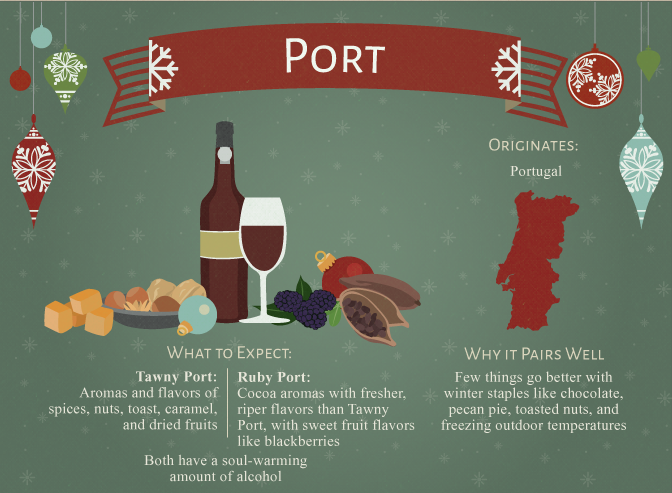
Madeira
The tiny Portuguese island of Madeira became famous for creating a style of fortified wine that could
survive long journeys overseas. Today, Madeira producers recreate the conditions of those voyages by fortifying
their wines, blending them, and exposing them to warm temperatures and oxygen throughout an
extended barrel aging.
The result is a wine redolent with dried fruit, Sherry-like notes, toast, nuts, and toffee, which naturally
conjures up images of winter desserts. As with Port, the fortification process raises the alcohol level of
Madeira to about 20 percent, so it also does admirable duty as a winter warmer.
Madeira is nearly as versatile as Port, available in different barrel-ages, and styles from dry (Sercial)
to very sweet (Malvasia). What’s more, because Madeira wine is so hardy, you don’t have to fret over
leaving some behind in the bottle. Given the right storage conditions, good Madeira can be enjoyed for
years without it changing its primary flavors, so you can look forward to a sip for many winter seasons to come.
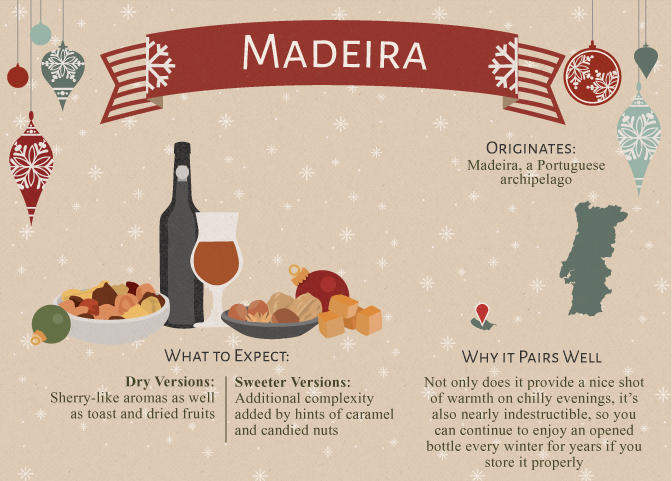
Tokaji
The small Hungarian area of Tokaji was once the epicenter of the fine-wine world, primarily for its
sweet wine made from grapes that have shriveled on the vine due to natural processes, which concentrates
the fruit’s sugar and acidity. The wine from here was so well regarded that it has been said that Louis XV of
France called it “Wine of Kings, King of Wines” when pouring it for Madame de Pompadour.
It’s difficult to get a higher recommendation than that.
Tokaji production relies on a special fungus called botrytis that affects the grapes and turns them
into raisins while still on the vine. This might not sound appealing (and those grapes certainly don’t
look appealing when they’re picked, either), but the fermented results are anything but icky – just ask
the next member of French royalty you happen to bump into.
While there are a few styles of Tokaji, the most well-known is Aszú, which has explosive flavors
of sweet apricot, coffee, orange rind, citrus zest, and golden raisins. It’s most impressive feature,
however, might be its vibrant, lip-smacking acidity, which helps it hold its own not only as an aperitif,
but also as a match for desserts of nearly all kinds.
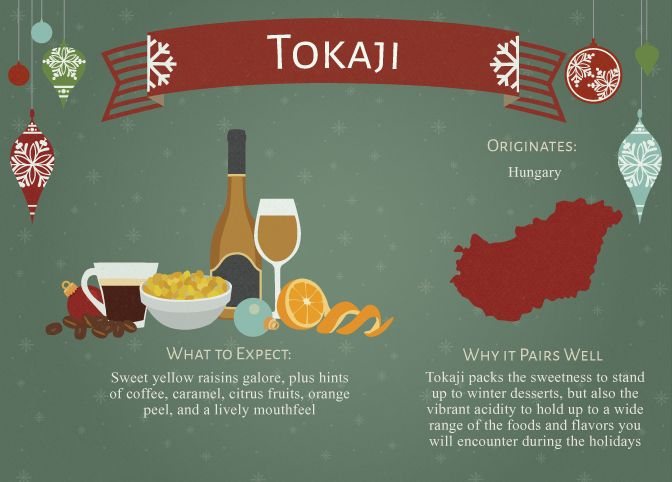
Doux Sparkling Wine
What would New Year’s Eve be without a glass of bubbly to toast the flipping of the calendar?
For starters, it would be a much less classy and less festive evening. Sparkling wine is probably already
a part of your winter holiday plans, but there’s an under-appreciated style of bubbly that is
especially luxuriant, and therefore a good match for the indulgent holiday season.
Doux sparkling wines are a sweet style of bubbly. While almost all sparkling wine has some
small amount of sugar added to help balance its racy, piquant acidity, Doux sparkling wines
ratchet that up a notch, adding over five percent sugar by volume. At that level, the
sweetness is noticeable above the vibrant acid and drying bubbles, imparting a richer
mouth feel than styles made with less sugar.
With Doux sparkling wines (particularly the better examples from France,
the U.S., and Italy), you get the apple and pear fruitiness, floral aromas, and
hints of toast that are part of the drier sparkling wine bottlings, as well as
sugar to satisfy your sweet tooth (and match up with holiday cakes).
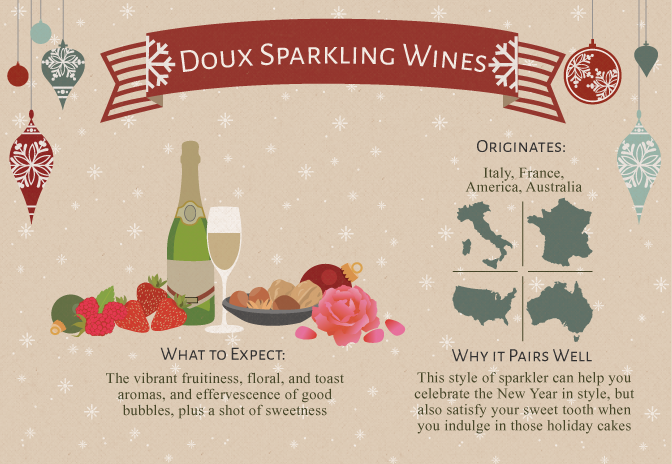
Ice Wine
Few people would want to join pickers harvesting grapes for one of the most beguiling dessert wines from Canada,
Germany, and the U.S.: ice wine. Ice wine harvests typically take place at night, in the frigid cold, when temperatures
reach a bone-chilling 17 degrees F. It’s then that the grapes freeze, and the ice surrounding them draws out the water
within the grapes, concentrating their flavors, acidity, and sugar.
While this style of dessert wine is expensive – hey, those poor folks hand-harvesting grapes in the freezing
cold need to get paid! – it’s worth a look if you prefer sweet wines that are intense, but also have a vibrant
mouth feel that isn’t overly cloying.
With the best ice wines, you’ll get citrus, stone fruit, and candy aromas and flavors that are focused,
intense, fresh, and pure. This all comes with ice wine’s bright acidity, which helps it feel refreshing despite
the high concentrations of sugar. And what could be more apt for winter than wine made from frozen grapes?
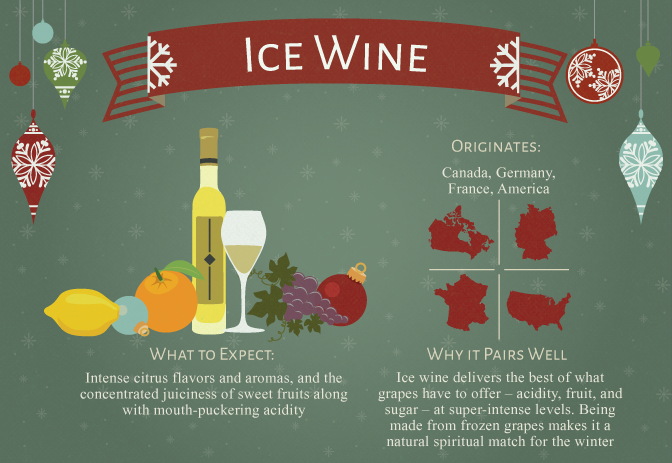
This holiday season, you don’t have to reach for the same vino that helped you ring in the seasons so far.
Instead, consider trying out one of the dessert wine styles above, and treat yourself to a tasty new drinking
experience, while you enjoy the sweet treats that mark the coming of winter and the holiday season.
Embed the article on your site

